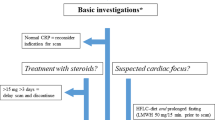Abstract
Objectives
The objectives of the study are to evaluate the role of multidetector computed tomography (MDCT), its sensitivity and specificity in recognizing the complications related to oncology, and its treatment in patients with known malignancies and to determine how clinician’s diagnosis, diagnostic dilemma, and management decisions are affected by the results of computed tomography (CT) in a tertiary care oncology setup.
Materials and methods
A thorough retrospective search of the database of 1 year in the Department of Radiology was done at our tertiary oncology center, of patients who were diagnosed or suspected with complications associated with cancer. In addition, patients, in whom acute emergencies were detected by the MDCT, were also included as these were mostly part of the complications related to the malignancies. A total of 207 patients were included after excluding patients in whom the final diagnosis was uncertain or in patients who died before a definitive diagnosis was made. Clinical details were noted and compared with the CT diagnosis of the complication.
Results
Out of the 207 patients, majority of complications were related to cardiovascular system [22.2%]. Gastrointestinal malignancies constituted the next most common [20.7%], followed by genitourinary [17.8%], central nervous system [9.6%], and respiratory system complications [8.2%]. The musculoskeletal and head and neck complications were seen in 4.8% of the total patients. The iatrogenic complications and those complications arising due to chemotherapy or radiotherapy were separated constituting about 5.3% of the total number of patients in the study. CT showed a sensitivity of 96.4%, specificity of 66.6%, positive predictive value of 98.4%, and negative predictive value of 46.1% in detecting these complications. Overall, CT detected 96.6% of complications which were not suspected clinically and detected 83% of complications supporting the clinical suspicion.
Conclusion
MDCT plays an important role in detecting the complications associated with malignancies. It helps in definitive diagnosis of those complications which are clinically suspected and also in recognizing those complications which may not be apparent clinically and thus can change the management strategies. This is probably the first comprehensive study in the English literature evaluating and highlighting the role of MDCT in recognizing various complications in patients with known malignancies.










Similar content being viewed by others
References
Cancer Facts & Figures (2017) American cancer society,https://www.cancer.org/content/dam/cancer-org/research/cancer-facts-and-statistics/annual-cancer-facts-and-figures/2017/cancer-facts-and-figures-2017.pdf
Guimaraes MD, Bitencourt AGV, Marchiori E, Chojniak R, Gross JL, Kundra V (2014) Imaging acute complications in cancer patients: what should be evaluated in the emergency setting? Cancer Imaging 14(1):18. https://doi.org/10.1186/1470-7330-14-18
Lewis MA, Hendrickson AW, Moynihan TJ (2011) Oncologic emergencies: pathophysiology, presentation, diagnosis, and treatment. Cancer J Clin 61:287–314
Katabathina VS, Restrepo CS, Betancourt Cuellar SL, Riascos RF, Menias CO (2013) Imaging of oncologic emergencies: what every radiologist should know. RadioGraphics 33:1533–1553
Higdon ML, Higdon JA (2006) Treatment of oncologic emergencies. Am FamPhys 74(11):1873–1880. Available at https://www.aafp.org/afp/2006/1201/p1873.html
Gladish GW, Choe DH, Marom EM, Sabloff BS, Broemeling LD, Munden RF (2006) Incidental pulmonary emboli in oncology patients: prevalence, CT evaluation, and natural history. Radiology 240:246–255
Saini DK, Chaudhary P, Durga CK, Saini K (2013) Role of multislice computed tomography in evaluation and management of intestinal obstruction. Clin Pract 3(2):e20. https://doi.org/10.4081/cp.2013.e20
Ferguson HJM, Ferguson CI, Speakman J, Ismail T (2015) Management of intestinal obstruction in advanced malignancy. Ann Med Surg 4(3):264–270. https://doi.org/10.1016/j.amsu.2015.07.018
Kaste SC, Rodriguez-Galindo C, Furman WL (1999) Imaging pediatric oncologic Emergencies of the Abdomen. Am J Roentgenol 173:729–736. https://doi.org/10.2214/ajr.173.3.10470913
Kuku S, Fragkos C, McCormack M, Forbes A (2013) Radiation-induced bowel injury: the impact of radiotherapy on survivorship after treatment for gynaecological cancers. Br J Cancer 109(6):1504–1512
Stamatakos M, Sargedi C, Stasinou T, Kontzoglou K (2014) Vesicovaginal fistula: diagnosis and management. Indian J Surg 76(2):131–136. https://doi.org/10.1007/s12262-012-0787-y
Torrisi JM, Schwartz LH, Gollub MJ, Ginsberg MS, Bosl GJ, Hricak H (2011) CT findings of chemotherapy-induced toxicity: what radiologists need to know about the clinical and radiologic manifestations of chemotherapy toxicity. Radiology 258(1):41–56. https://doi.org/10.1148/radiol.10092129
Yu NC, Raman SS, Patel M, Barbaric Z (2004) Fistulas of the genitourinary tract: a radiologic review. RadioGraphics 24(5):1331–1352
Jia JB, Lall C, Tirkes T, Gulati R, Lamba R, Goodwin SC Chemotherapy-related complications in the kidneys and collecting system: an imaging perspective. Insights into Imaging 6(4):479–487. https://doi.org/10.1007/s13244-015-0417-x
Singer S, Grommes C, Reiner AS, Rosenblum MK, DeAngelis LM (2015) Posterior reversible encephalopathy syndrome in patients with cancer. Oncologist 20(7):806–811. https://doi.org/10.1634/theoncologist.2014-0149
Iqbal N, Sharma A (2013) Cerebral venous thrombosis: a mimic of brain metastases in colorectal cancer associated with a better prognosis. Case Rep Oncol Med 2013:109412. https://doi.org/10.1155/2013/109412
Gaur P, Dunne R, Colson YL, Gill RR (2014) Bronchopleural fistula and the role of contemporary imaging. J Thorac Cardiovasc Surg 148(1):341–347. https://doi.org/10.1016/j.jtcvs.2013.11.009
Fayad LM, Kawamoto S, Kamel IR, Bluemke DA, Eng J, Frassica FJ, Fishman EK (2005) Distinction of long bone stress fractures from pathologic fractures on cross-sectional imaging: how successful are we? Am J Roentgenol 185(4):915–924
Lu L, Lou Y, Tan H (n.d.) Chemotherapy-induced fulminant acute pancreatitis in pancreatic carcinoma: a case report. Oncol Lett 8(3):1143–1146. https://doi.org/10.3892/ol.2014.2316
Funding
This study was not funded.
Author information
Authors and Affiliations
Corresponding author
Ethics declarations
Our study complies with the ethical standards.
Conflict of interest
The authors declare that they have no conflict of interest.
Additional information
Publisher’s Note
Springer Nature remains neutral with regard to jurisdictional claims in published maps and institutional affiliations.
Rights and permissions
About this article
Cite this article
Rao, A., Parampalli, R. Role of MDCT as an effective imaging tool in detection of complications amongst oncological patients in a tertiary care oncology institute. Emerg Radiol 26, 283–294 (2019). https://doi.org/10.1007/s10140-019-01671-6
Received:
Accepted:
Published:
Issue Date:
DOI: https://doi.org/10.1007/s10140-019-01671-6




